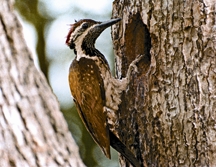Woodpecker

Woodpecker (kaththokra) a group of slender birds with very flexible necks, strong, chisel-tipped bills, and very long protrusible tongues.
They belong to the family Picidae, order Piciformes. Most live in trees, using their long claws to grip the bark and long stiff tails to brace the body while they probe for insects or excavate a nest. Included in the family are about 204 species; Bangladesh having 22 species: 21 resident, and one migratory (Table).
Table Woodpeckers of Bangladesh (Class: Aves).
| Scientific name | English name | Local name |
| Blythipicus pyrrhotis | Bay Woodpecker [Redheaded Bay Woodpecker] | --- |
| Celeus brachyurus [Micropternus brachyurus] | Rufous Woodpecker | Lalchey Kaththokra |
| Chrysocolaptes lucidus | Greater Flameback [Larger Goldenbacked Woodpecker] | --- |
| Dendrocopos atratus [Picoides atratus] | Stripe-breasted Woodpecker [Stripe-breasted Pied Woodpecker] | --- |
| Dendrocopos canicapillus [Picoides canicapillus] | Grey-capped Pygmy Woodpecker [Grey-crowned Pygmy Woodpecker] | Dhushar Matha Baman Kaththokra |
| Dendrocopos hyperythrus [Hypopicus hyperythrus] | Rufous-bellied Woodpecker [Sapsucker] | --- |
| Dendrocopos macei [Picoides macei] | Fulvous-breasted Woodpecker [Fulvous-breasted Pied Woodpecker] | Pakra Kaththokra |
| Dendrocopos mahrattensis [Picoides mahrattensis] | Yellow-fronted Pied Woodpecker | Pakra Kaththokra |
| Dendrocopos nanus [Picoides nanus] | Brown-capped Pygmy Woodpecker [Pygmy Woodpecker] | Ban Kaththokra |
| Dinopium benghalense | Black-rumped Flameback [Lasser Goldenbacked Woodpecker] | Kaththokra |
| Dinopium javanense | Common Flameback [Indian Goldenbacked Threetoed Woodpecker] | --- |
| Dinopium shorii | Himalayan Flameback [Himalayan Goldenbacked Threetoed Woodpecker] | --- |
| Gecinulus grantia | Pale-headed Woodpecker | --- |
| Hemicircus canente | Heart-spotted Woodpecker | --- |
| Mulleripicus pulverulentus | Great Slaty Woodpecker [Himalayan Great Statyheaded Woodpecker] | --- |
| Picus canus | Grey-headed Woodpecker [Blacknaped Green Woodpecker/ Grey Woodpecker | --- |
| Picus chlorolophus | Lesser Yellownape [Small Yellownaped Woodpecker] | --- |
| Picus flavinucha | Greater Yellownape [Large Yellownaped Woodpecker] | --- |
| Picumnus innominatus | Speckled Piculet | SKhudey Kaththokra |
| Picus xanthopygaeus [Picus myrmecophoneus] | Streak-throated Woodpecker [Little Scaly-bellied Green Woodpecker] | Sabujey Kaththokra |
| Sasia ochracea | White-browned Piculet [Rufous Piculet] | Lal Khudey Kaththokra |
| Migratory | ||
| Jynx torquilla | Eurasian Wryneck [Wryneck] | Metho Kaththokra |
Woodpeckers vary in size from that of a sparrow to that of a crow. Their colour pattern is usually bold, including black and white or olive. Often there are areas of red on the head. Their flight is heavy and undulating. Most woodpeckers have loud voices and some are noisy. They drum with the bill, particularly during nesting season and when they have found a resonant surface. Courtship flights and displays are shown at mating time. The nest is usually an excavation chiselled in a tree trunk, in which usually two whitish eggs are laid without the addition of nest material. Some species may lay as many as 8 or 10 eggs. Both parents share nest duties.
The green woodpecker (Picus viridis) of Europe and the flickers (Colaptes) of the Americas feed on insects on the ground, away from trees, and one South American species lives entirely in open country, feeding on the ground and making its nest in holes in banks. The South African Ground Woodpecker (Geocolaptes olivaceus) has similarly forsaken forests for open country. The wrynecks are the only members of the woodpecker family that do not excavate their nests; they use natural cavities or old woodpecker or barbet holes. [Md Anwarul Islam]
